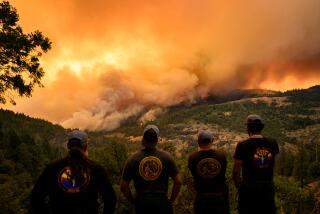Risky measures to save big trees from Rim fire worked
YOSEMITE NATIONAL PARK, Calif. — Each afternoon the fire’s thunderous plume rose.
At night, helicopter crews at the Crane Flat lookout watched a line of orange burning across the horizon. The line kept drawing closer.
By the last week of August, every effort to halt the Rim fire before it moved deeper into the national park had failed. The blaze now had a clear path to the Tuolumne and Merced groves of giant sequoia, and the Rockefeller grove, one of the last stands of giant sugar pine untouched by logging.
On Aug. 30, a Friday, a group of firefighters gathered at the lookout to launch a risky plan to protect some of Earth’s oldest and largest living organisms.
Even Ben Jacobs, the division commander, was nervous.
Jacobs, 55, had fought wildfires and managed prescribed burns at Sequoia Kings Canyon National Park. But he had seen crews take chances earlier in the week trying to save family camps and businesses. If they’d gambled for buildings, what would they do for living giants?
He also worried that if crews lost control of the backfires they were about to ignite, flames could spread for miles, even as far as the Merced River, west of the park’s famous valley.
“Listen,” he said. “Nobody wants to be the guy who burned down Yosemite.”
::
They had known a fire like this was coming.
A hundred years of fire suppression had created a buildup of trees, logs and other fuels. Fire could climb up and fly through the crowns of trees rather than burn on the ground as forest fires had for centuries. Add two years of extreme drought, and the Sierra Nevada was a pile of kindling.
Inside Yosemite, officials had tried to restore the natural cycle of fire. For 40 years, lightning-sparked flames in wilderness areas had been left to burn, and specialists lighted controlled burns near tourist areas. But that might not offer enough protection.
“Hypothetically those old fire scars would slow the fire the further it moved into the park,” said Gus Smith, Yosemite’s fire ecologist. “But the Rim fire was like a flood, and it was coming. This was not the fire you wanted to test out a hypothesis.”
It had first been spotted in a remote area of neighboring Stanislaus National Forest.
Two days later, on Aug. 17, flames exploded over a ridge above the Tuolumne River. Whitewater rafters navigating the canyon of buckeyes and bald eagles said it sounded like bombs.
It was about 20 miles in the distance, but Yosemite Fire Chief Kelly Martin, a specialist in predicting fire behavior, knew it was headed their way.
“This is it,” she said. “This is the Big One.”
Now, it had pushed 30 miles inside the park, moving south toward California 120 — the main east-west route through Yosemite. In one day it had burned 50,000 acres inside the park. The biggest fire since the park began keeping records in 1930 had burned 46,000.
The sequoias evolved to face wildfire. But officials feared that this fire could kill even trees that had been shrugging off flames since before Rome burned.
Jacobs and Taro Pusina, Yosemite’s deputy fire chief, drew up a plan. They would set three coordinated backfires and try to stop the wildfire with a “catcher’s mitt” of charred earth.
But first they would wind the fires through two of the very groves they were trying to protect. The Tuolumne and Merced groves were at the top of a ridge, in the direct line of the Rim fire, in an area that had not burned for 100 years. If the hotter Rim fire reached them, it could climb to the tops of 200-foot trees.
A lot could go wrong. If the backfires were too hot, they could cook the groves. If they did not burn enough ground in time, the Rim fire would roar through unblocked. Those two groves and the Merced Grove to the south would burn, the lookout tower and helicopter base would burn, and the firefighters would have to run.
“We knew it was a longshot,” Pusina said. “But no amount of bulldozers or planes or crews had stopped this fire. We were out of options.”
::
They met at the lookout peak at 1:30 p.m. that Friday. The flames were two miles away — a mile closer than the day before.
They lighted a test blaze. The plants were so dry that flames shot over 50 feet high at the edge of the helipad.
“So, OK. Looks like we’re going to have our hands a little bit full,” said Pusina, the deputy fire chief, drawing a laugh.
Hotshot crews hiked down to the Rockefeller grove. It was purchased in 1930 with the help of a $1.7-million donation from John D. Rockefeller, saving the towering sugar pines about to be cut for timber and expanding the national park.
With a drip torch mixing three parts diesel and one part gasoline, crews started a line of fire.
“I’m not a big guy of faith,” said Smith, the Yosemite fire ecologist. “But at that moment, we’re committed. You just had to let go and believe that it was going to be the right thing.”
Winds blew smoke and flames back, as the crew pushed the fire into thousands of acres of sugar pines, cedar and ponderosa.
“C’mon, c’mon. You have to move faster,” Jacobs told them.
All through the night, the grove growled and crashed with fire.
The next day, with the first grove still burning, a handful of firefighters drove into the Tuolumne grove, a mile to the east.
A fire crew from Arizona had prepared the area — raking debris away from trees, sawing snags and logs. Many of them had never seen a giant sequoia, which is native only on the western slope of the Sierra Nevada. The species dates back to the Ice Age.
“They were in awe of the trees. They kept looking up as they worked,” recalled Gary Oye, division chief of wilderness stewardship.
When Jacobs arrived, the first thing he had the Arizona crew do was pull out the sprinkler system that had been installed as a backup plan. The grove was crowded and there were few young trees. Sequoias thrive in fire as long as it does not reach their canopies. It helps cones disperse seeds and makes room for new growth.
“If we were going to do this, I wanted to know the grove was going to be here in a thousand years,” Jacobs said. “I wanted to picture seedlings and saplings.”
He gave drip torches to the Arizona firefighters, who would set small fires amid the massive landmark trees, then get out.
Smoke curled around the enormous trunks with red bark that hangs like candle drippings. Small fires glowed through the grove. On the ridge, hotshots laid out flames. A mile away, a super blaze kept coming.
“It felt like a moment out of time,” Oye said. “You knew these trees had seen this before and survived. Man had almost destroyed them. But this time man was trying to save them.”
Pusina said he felt a sense of solace.
“I know it sounds cheesy — but I swear I could hear the trees sigh with relief. They wanted our fire,” he said. “They knew the Rim fire was out there.”
At Crane Flat, crews lighted a fire to burn east and meet the Tuolumne blaze. By 9 p.m., the backfires linked.
There was a thin black line between the ancient trees and the Rim fire.
::
Smith, the fire ecologist, anxiously waited for the flames to die down so he could get to the trees. He was most concerned for the sugar pines, which nature built to resist flames. But nothing was as fireproof as a sequoia, with its soft, stringy, 2-foot-thick bark.
That Thursday, he hiked a fire line into the Rockefeller grove. Helicopters and planes buzzed overhead. The Rim fire, now the third-largest in California history, was still being fought on other fronts.
His shoulders slumped when he saw a tall cedar, cut down, a fire burning within it.
“That was my favorite cedar. It had fire in it for a long time,” he said.
The ground was thick with pieces of things that once were — giant logs, young trees, craggy snags burned down to charcoal. Corkscrews of smoke rose across the landscape, bowls of stumps and fallen trees burned orange.
Smith stamped out a flame with his shovel. He bent to look at bear tracks. He fingered dogwood, some of the leaves still green and listened to the song of a nuthatch.
He studied the bottom of the trunks of burned trees. If there had been a lot of pine needles and cones piled up at the base, the fire could have ringed them with too much heat and cut off their vascular system. They would stand for now, providing shelter for birds and animals but be dead within seven years.
“You might make it,” he said to a towering pine with a black ring stretching less than halfway around.
Deep in the grove, 400-year-old sugar pines still stood. There were few girdle marks.
Smith turned slowly in a half circle looking up at the fluttering green canopy hundreds of feet above. He smiled.
“Come back in the spring,” he said. “This is going to be gorgeous.”
More to Read
Sign up for Essential California
The most important California stories and recommendations in your inbox every morning.
You may occasionally receive promotional content from the Los Angeles Times.











